What is a fax number, and why is it still important in a time when instant messaging, emails, and cloud storage are the norm? Because of its security and legal dependability, faxing is still a crucial communication tool in sectors like healthcare, law, and finance.
A fax number is a specific phone number that is used to electronically send and receive documents through an online service or fax machine. Millions of faxes are still sent every day worldwide, despite the fact that many people believe that faxing is obsolete, how it functions, why it’s still in use in 2025, and how to send and receive faxes without a cumbersome device. We’ll also examine how the idea of a fax phone number changed over time and why it may be more important than you might think.
Breaking Down the Basics: What is a Fax Number?
A fax number is a unique sequence of digits, just like a telephone number, used to send and receive documents electronically via a fax machine or online fax service. Sending a fax basically involves sending a digital scan of your document to the recipient’s fax number via a phone line.
How It Works (The Traditional Way)
- You enter the recipient’s fax phone number into your fax machine.
- The machine dials that number using a landline.
- Once connected, it sends the document as a series of audio tones.
- The recipient’s machine decodes the signal and prints the document.
Doesn’t it sound like something from the 1990s? However, faxing continues to be the gold standard for safe and dependable document transmission in certain sectors, including healthcare, law, government, and finance.
What is a Fax Phone Number, And Is It Different?
People often use “fax phone number” and “fax number” interchangeably, but they have subtle differences:
- Fax number: Specifically routes incoming documents to a fax machine or digital fax inbox.
- Fax phone number: Emphasizes that the number connects to a phone line used exclusively (or primarily) for faxing.
In essence, a fax phone number is a telephone number enabled for fax transmission. Some businesses use dedicated lines for faxing, while others use fax-to-email services that operate without any hardware.
The Evolution: From Bulky Machines to Cloud Faxing
Faxing has come a long way. Remember those noisy, clunky machines with thermal paper and constant paper jams? Thankfully, digital innovation has made faxing far more practical in today’s remote and paperless environments.
Enter Online Fax Services
Platforms like eFax, MyFax, and HelloFax let users send and receive faxes via email or mobile apps. Here’s how it works:
- You sign up and get assigned a digital fax number.
- To send a fax, you upload your document and enter the recipient’s fax number.
- To receive one, the sender faxes your number, and you accept it as a PDF in your inbox.
This transition means you no longer need physical fax machines, or even a dedicated phone line. It also makes faxing more secure, efficient, and environmentally friendly.
Why Do Fax Numbers Still Exist in 2025?
At first glance, faxing seems unnecessary in an age of Slack, Google Drive, and DocuSign. But several factors keep fax numbers alive and well:
1. Security & Compliance
Faxing is considered one of the most secure methods for sending sensitive data. In industries governed by regulations such as HIPAA (healthcare) or FINRA (finance), digital faxing ensures confidentiality through audit trails and encryption.
2. Universal Accessibility
Fax technology doesn’t rely on internet access, making it viable in rural or low-tech areas. Additionally, it’s compatible across systems, eliminating file format conflicts and download errors.
3. Legal Standing
In many jurisdictions, a signed faxed document holds the same legal validity as an original. While digital signatures are gaining ground, faxes remain a reliable and legally secure option.
4. Legacy Systems
Some businesses, particularly in the insurance or legal sectors, still rely on legacy infrastructure that integrates fax as a standard communication method. Removing or replacing it is costly and risky.
Personal Insight: My First (And Last) Fax Machine
A few years ago, I assisted a family member in refinancing their home. The lender requested income verification via fax. I didn’t own a fax machine, and buying one seemed absurd. So I tried an online fax service with a free trial.
Here’s what surprised me:
- It took less than 5 minutes to set up.
- I got my fax number instantly.
- The document was delivered and confirmed, all from my laptop.
Faxing isn’t outdated, it’s simply misunderstood. It has evolved, quietly adapting over time, ready to step in and deliver when we need it most.
How to Get Your Fax Number in 2025
Whether you’re running a business or need to fax a few times a year, here are your options:
Traditional Fax Line
- Requires a landline and fax machine.
- Best for high-volume, in-office environments.
- Expensive and less flexible.
Online Fax Service
- Choose a plan (many start at $9.99/month).
- Receive a digital fax number (local, toll-free, or international).
- Send/receive faxes via web, email, or app.
Fax Apps for Mobile
- Use apps like Fax.Plus or iFax on your phone.
- Great for on-the-go professionals.
- Many offer OCR and e-signature integration.
Choosing the Right Fax Solution
Before deciding, consider:
1. Cost
- Traditional Fax: Typically quite expensive, as it requires physical equipment such as fax machines and dedicated phone lines. It’s an upfront investment plus ongoing maintenance.
- Online Fax: More budget-friendly with a subscription model. You pay a monthly fee that covers the service, eliminating the need for extra hardware.
- Mobile App Fax: Often the most affordable or even free, as you use your smartphone and internet connection, with no extra equipment or lines required.
2. Ease of Use
- Traditional Fax: Can be tricky, especially if you’re not tech-savvy. Setting up and using fax machines, managing paper, and dialing numbers manually is less straightforward.
- Online Fax: Much simpler, you just upload documents online and send or receive faxes digitally, no fumbling with paper or machines.
- Mobile App Fax: Super easy and convenient; you can fax directly from your phone, anytime, anywhere, often with just a few taps.
3. Accessibility
- Traditional Fax: Tied to your office or wherever the fax machine lives. You need to be physically there to send or receive faxes.
- Online Fax: Accessible from any device with internet, your home, office, or on the go. Perfect for remote work or traveling.
- Mobile App Fax: Ultimate flexibility, send or receive faxes right from your pocket, wherever you are.
4. Security
- Traditional Fax: Very secure because it’s a direct line and paper-based, less prone to hacking.
- Online Fax: Generally secure, especially when services use encryption to protect your documents in transit.
- Mobile App Fax: Security can vary significantly depending on the app you use, some have strong encryption, while others may be less secure. Always pick reputable apps!
Common Questions About Fax Numbers
Can I use my phone number as a fax number?
Not simultaneously. If you use your phone number for voice calls, you will require a separate line or an online fax service to receive faxes.
Is a fax number the same as an email address?
No, but online fax services link them. Your fax number receives documents; the system forwards them to your email as attachments.
Can I fax without a fax machine?
Absolutely. All you need is an online fax service or mobile app.
Is Faxing Still Necessary in 2025?
While faxing may seem like a relic of the past, it remains vital in sectors where security and compliance matter. Understanding what a fax number is helps businesses and individuals navigate legal, medical, and financial communications effectively.
Faxing may no longer dominate headlines, but like a dependable old friend, it shows up when it counts.
Do you need a fax number for your business? Try eFax’s free trial and experience seamless digital faxing today!







